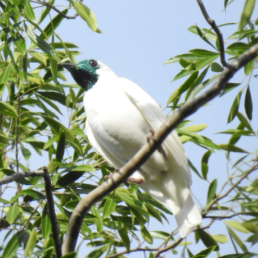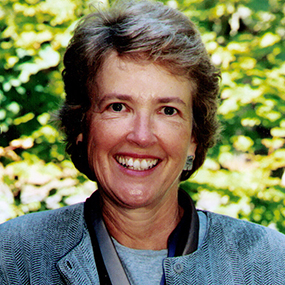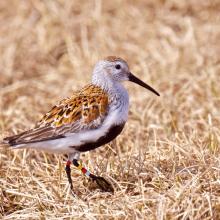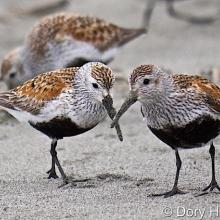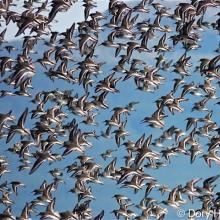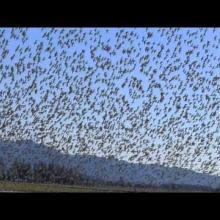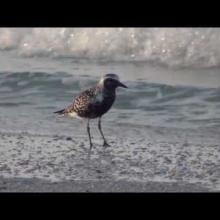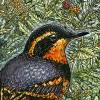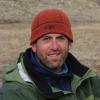

Join BirdNote tomorrow, November 30th!
Illustrator David Sibley and actor H. Jon Benjamin will face off in the bird illustration battle of the century during BirdNote's Year-end Celebration and Auction!
Shorebirds rely on tidelands and mudflats for food, especially in winter when conditions are tough. Join us on this blustery day to count birds such as these Dunlin at an estuary in western Washington State. The results will go into the Avian Knowledge Network to support the conservation and management of estuaries that benefit shorebirds.
How many do you see?
BirdNote®
Counting Shorebirds in Winter -
For the Avian Knowledge Network
With Gary Slater, Keith Wiggers and Jan Wiggers
Interview by Todd and Chris Peterson
This is BirdNote!
[Flock of Dunlin on an estuary + winds of winter]
Shorebirds rely on tidelands and mudflats for food, especially in winter when conditions are tough! Join us, this blustery day, to count birds like Dunlin and Black-bellied Plovers at a huge estuary in Western Washington.* Our count is part of an annual survey,** the results of which will go into the Avian Knowledge Network.
But just how do you count thousands of birds?
[Large flock of Dunlin]
Here’s volunteer Keith Wiggers:
“What you try to do, depending upon how big a group it is…you just kind of count ten and ten and ten and get a feel for how many ten is, and then as the group grows you get a hundred, and then you count by hundreds…”
Gary Slater, Director of Ecostudies Institute, explains the protocol:
“The survey area is defined out from our location on the dike out to three to five hundred yards…So the goal is to be here on a tide that’s rising so the birds are being pushed towards the observers, and what you’re going to do is count any shorebirds that land within the defined survey area…”
Jan Wiggers tallies the birds:
“The sitting ones, we have a total Dunlin count of 1,970…and one Black-bellied Plover...”
To conserve and manage estuaries that benefit shorebirds requires knowing how many birds use the area and what habitats they occupy. There’s more at birdnote.org.
[Call of Dunlin]
###
Bird sounds provided by The Macaulay Library of Natural Sounds at the Cornell Lab of Ornithology, Ithaca, New York. Flock of Dunlin [59435] recorded by W.W.H. Gunn; calls of individual Dunlin [138217] recorded by G. Vyn.
Wind Nature Essentials #2 recorded by Gordon Hempton of QuietPlanet.com.
Ambient recorded by C. Peterson (MV T 452, T 457).
BirdNote’s theme music was composed and played by Nancy Rumbel and John Kessler.
Producer: John Kessler
Executive Producer: Chris Peterson
© 2014 Tune In to Nature.org January 2014 Narrator: Michael Stein Marantz V Tracks 438, 450
*The Skagit-Stillaguamish estuary is a site of regional importance in the Western Hemisphere Shorebird Reserve Network (WSHRN) http://www.whsrn.org/western-hemisphere-shorebird-reserve-network
** Puget Sound Shorebird Survey (PSSS) is a part of a larger, flyway-wide survey http://data.prbo.org/apps/pfss/ that helps guide the conservation and management of shorebirds, most of which are thought to be declining.
Skagit Audubon https://www.skagitaudubon.org/
Pacific Coast Joint Venture https://pacificbirds.org/
Avian Knowledge Network http://www.avianknowledge.net/content/about/
Ecostudies Institute https://ecoinst.org/
